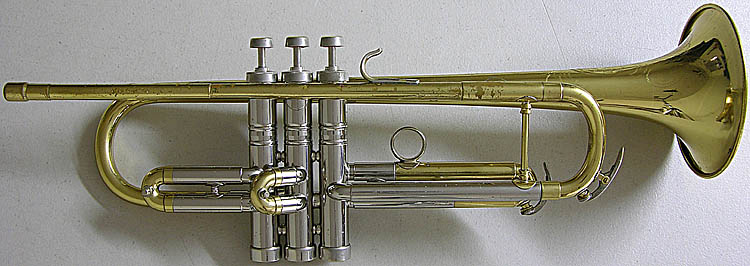Conn 6A Victor "Early Model"

Date: 1956, Owner unknown. Picture courtesy of Al Gottesman at Lauderdale Wind Inc.
The 6A Victor is the long cornet version of the 6B Victor trumpet. This means that the mouthpiece receiver is built for a cornet mouthpiece and not a trumpet mouthpiece, and the internal bore is a bit different: the leadpipe is just an outer cover, hiding an inner leadpipe that tapers differently than it does on a trumpet. The "early" version has a fixed 3rd slide finger ring, bottom spring valves and is brass with nickel trim. The 6A has a #1 bore (0.438"). Production of the 6A started in 1956. The "early" model was produced through 1957.
Mouthpiece wise, the 6A and 10A Victor models and the 28A Connstellation were built right in the years when Conn appears to have transitioned from short shank to long shank. I know that prior to 1955 Conn cornets were short shank only. From 1958 on they were long shank only. The intervening years, 1955-1957, are a bit uncertain. The 6A and 10A will accept both long and short shank cornet mouthpieces. I have played my 1956 10A with both types of mouthpieces and find that the short shank mouthpiece has less resistance and seems to respond better. However, I am told that the 1956 and 1957 6A and 10A Victor models originally came with long shank mouthpieces. So take your pick. If you own a 1955-1957 28A Connstellation, 10A Victor or 6A Victor, you might want to try it with a short shank cornet mouthpiece if you have one available, to compare and make up your own mind. For more information, drop me an e-mail.
How to tell a 6A Victor long cornet and a 6B Victor trumpet apart? The differences are quite subtle, but you should be able to tell if you know what you are looking for. All models for which there is both a long cornet and a trumpet (6A/6B, 10A/10B, 28A/38B) have a letter "A" or "B" stamped on the mouthpiece receiver. An "A" indicates a cornet leadpipe, a "B" indicates a trumpet leadpipe. The second way is to look at where the leadpipe widens out to accomodate the main tuning slide. On a trumpet this happens directly after the leadpipe finger hook, on a long cornet about an inch further down the leadpipe from the fingerhook. See picture. For a discussion on the merits of long model cornets such as this one, see The Long Model Cornet: Fish Nor Fowl?.
As far as I can tell at this point, all Conn cornets built before 1958 take a short shank cornet mouthpiece as opposed to the 2¾" "Bach-style" long shank cornet mouthpiece. The long shank cornet mouthpieces won't properly fit a pre-1958 Conn cornet and won't give the proper intonation or playing characteristics of a short shank cornet mouthpiece. All of Conn's "Connstellation" cornet mouthpieces are long shank mouthpieces. The "Improved Precision" Conn mouthpieces such as the Conn 4 are long shank if there is a "ridge" halfway down the shank, and short shank if there is no ridge (in which case it is a "Precision" mouthpiece). All Conn cornet mouthpieces built before the "Improved Precision" series (ridge), such as the "Precision" series (no ridge) are short shank mouthpieces.
Also see the 6A Victor "Late Model".
What Conn said in 1957:
New design that looks like a trumpet ... easier to blow, easier to handle. Acoustical
qualities similar to those of the 28A Connstellation. Features Clickless Crysteel valves
with bottom springs for fast, smooth, positive action and quiet performance. Nickel silver finger hook,
third valve ring, and water keys. Length 21 3/8", weight 2 lbs. 10 oz., bell diameter 5 1/8". Outfit
includes attractive, sturdy Victor case, correct mouthpiece and music lyre.
Highly polished brass, beautifully nickel trimmed, protected by long lasting, acid resistant LUSTRE-CONN
finish.